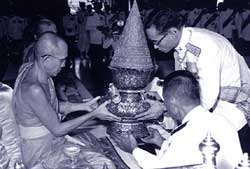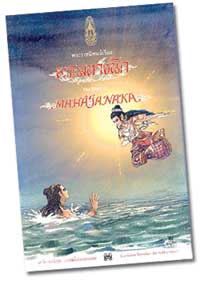 The King of Thailand, Bhumibol Adulyadej, has never visited Nepal. But he has always shown great affinity for the birthplace of the Buddha and for the Mithila kingdom which was ruled by King Janak.
The King of Thailand, Bhumibol Adulyadej, has never visited Nepal. But he has always shown great affinity for the birthplace of the Buddha and for the Mithila kingdom which was ruled by King Janak. Few know of King Bhumibol's abiding interest in the life and times of the king of Videha. So impressed was he with the story of Janak, as recounted in the Tripitaka, the sacred texts of Theravada Buddhism, that he published the book, The Story of Mahajanaka which is now being translated into Nepali. The English illustrated version, translated from the original Thai, was published in 1999. Now, King Bhumibol's daughter, Princess Maha Chakkri Sirindhorn who is a keen student of linguistics and Sanskrit, is taking her father's research interest in King Janak and Mithila further.
Today's Janakpur in Nepal was probably the old capital of Videha (and continues to be the cultural capital of Mithila), though the political capital of the kingdom subsequently shifted to Darbhanga in eastern Bihar. Hindu religious texts extol King Janak as an illustrious ruler. Not only was he the father of Sita, but also a philosopher-king who ruled justly over his kingdom. He was known to be a generous host during his reign, in whose court well-known sages conducted religious discourses. He was also a wise king-even rishis extolled his learning and erudition. There is little doubt that King Bhumibol (pic, at right paying respect to a monk recently) sees his role as a modern-day Janak.
It is not clear if Mahajanaka refers to a particular king or to a dynasty that ruled Videha. From the Buddhist texts, it appears that Janak was the name of a dynasty, with the particular illustrious monarch being called 'Mahajanaka'. The dates are also murky, although it is obvious he must have preceded Gautam Buddha of Kapilvastu. Mahajanaka is the story of one of the lives of the Buddha (before he became reborn as Siddhartha Gautam, the Prince of Kapilavastu) mentioned in the Tripitaka.
King Mahajanaka practiced perseverance without the desire for reward which resulted in his gaining the throne and bringing prosperity and wealth to the kingdom of Videha and the city of Mithila by the strength of his qualities.
In 1977, Thailand's King Bhumibol happened to be listening to a sermon about King Mahajanaka as recounted in the Jataka. A particular episode related to King Janak's visit to the royal park in the city of Mithila struck King Bhumibol. At the entrance of the park were two mango trees, one bearing fruit and the other barren. The king tasted the delicious mango fruit then entered the park. On return, he saw that the mango tree with the tasty fruits had been vandalised and uprooted by his elephant mahouts, horse handlers and courtiers. The other tree was left proudly standing. The incident of the mango trees demonstrated that good things are ironically the target of greed and are in danger of being destroyed.
After listening to this religious discourse 25 years ago, King Bhumibol felt that the story clearly demonstrated a worthwhile lesson and should be of great benefit for everyone. He started working on the book and wrote the story with some modifications vis-?-vis the original story from the scriptures in order to make it more relevant to contemporary times, and to get some of his own messages across.
 For instance, he has improvised the original text in the section on how the mango tree had been vandalised. In this portion he discusses nine methods that can be employed to restore the mango tree to its former state. The king is an avid agriculturist, and has even patented a pond aerator used by Thai farmers.
For instance, he has improvised the original text in the section on how the mango tree had been vandalised. In this portion he discusses nine methods that can be employed to restore the mango tree to its former state. The king is an avid agriculturist, and has even patented a pond aerator used by Thai farmers. The book is illustrated by prominent Thai artists, and the final outcome is such that The Story of Mahajanaka is easily as enjoyable for a children of nine as it is to their grandparents. The English illustrated version was an instant bestseller in Thailand. In the preface, the author has expressed his intention that the story might become an object of constructive contemplation for all well-meaning people.
The king's publication of the book coincided with the Asian economic crisis during which Thailand's real estate bubble burst, tens of thousands were laid off, the stock market crashed and the Thai baht plummeted. The underlying themes of self-reliance, moderation and compassion in the story of King Janak struck a chord with the king's Thai subjects who were increasingly disenchanted with materialism in an era of instant gratification.
The king is known to have expressed his uneasiness with Thailand being labeled an 'Asian Tiger'. His Buddhist inclinations aside, he favours a reasonable state of well-being, allowing for logical consumption while using minimum resources. He is sympathetic to the philosophy of E F Schumacher's 'Small is Beautiful' school.
The book uses dharma riddles and has lead some to suspect that it may be semi-autobiographical. Some years back, it was rumoured that the king was contemplating abdicating and retiring into a monastery. The king's attachment to Buddhism is well known, and in 1956 he had taken the vows and had become a Buddhist monk for two weeks. In The Story of Mahajanaka, the section concerning the mango trees has a part where King Mahajanaka thinks his desire to leave the city on a quest of supreme tranquility was premature because Mithila's prosperity had not yet reached a peak. Many took this passage to be autobiographical. Just as in the case of King Janaka of Videha, King Bhumibol may have felt that it was not the time to abdicate.
The Story of Mahajanaka by King Bhumibol Adulyadej (which in Sanskrit would be written Bhumibal Atulyatej or 'Strength of the Land and Immeasurable Splendour') has clear evidence that the monarch has put a lot of work to bring his research into its current shape. The Thai king appears to have learnt Sanskrit and closely studied the geography of the part of Nepal and India covered by the ancient Vidhea empire. The king has even sent his assistants to Janakpur to take pictures, and especially to look out for two mango trees that may look like the ones in the story.
The illustrations were done under the king's direct supervision, and show familiarity with ancient Indic dress, building structures and character traits, though some of the styles have been modified to suit Thai sensibilities. The charts drawn in the illustrated book reveal King Bhumibol's familiarity with the subcontinent's geography accurately identifying Mithila, Varanasi, Ayodhya and Mount Kailash. There is some speculation as well: he identifies Thailand with the legendary Suwannaphumi ('Suwarnabhumi'). A Nepali bhikku at the royal monastery, Wat Bovoranives, Phra Vippassi is translating King Bhumibol's The Story of Mahajanaka from Thai into Nepali for the benefit of the Nepali public.
Sudhindra Sharma is a visiting scholar at The Institute of Asian Studies at Chulalongkorn University in Bangkok. [email protected]


